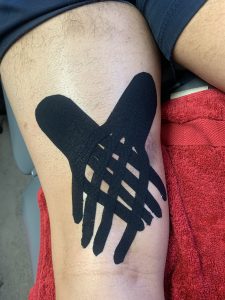The term “sprain” is often used to loosely describe pain associated with muscles, tendons, and ligaments. It is a stretch or tear of one of the structures mentioned above. Some of the common
sprains we see are:
1. Rolled ankle. When an ankle is rolled the ligaments on the outside can stretch or tear. The surrounding tendons may also stretch.
2. Shoulder sprain. Pain is often associated with heavy lifting over head or wrenching it backwards.
3. Hamstring sprain. Mostly occur when changing speed of walking/running quickly often when a warmup was not completed.
What you feel may vary from injury to injury but mostly consist of pain, swelling, bruising, reduced range of motion and/or inability to walk or use a limb. If you think you may have sprained a muscle but cannot get in to see us until a few days later, here are a few easy tips to help you get started. Have a look at this Hamstring sprain below:
POLICE
Protect – It is important protect the injury site from further injury. This includes, not stretching the injury site, if there is a possibility of a tear then stretching may make it worse.
Optimal Loading – When the sprain is mild we recommend trying to keep it moving and using the limb (arm or leg) as much as you are able but keeping the pain below a 2/10 in intensity.
Ice – Recent evidence is showing controversy over the use of ice. So, if it makes you feel better continue to use it! If not, then don’t worry as research is showing that we need the inflammation initially to help healing.
Compression – Compression socks or Tubigrip can be great to minimise excessive swelling in a joint or muscle belly.
Elevate – If possible, while sitting keep the body part up above or inline with your heart. This helps with swelling and drainage of the swollen injury site.
Pain Relief
Current evidence suggests that the use of non-steroidal anti-inflammatory such as ibuprofen or diclofenac when you have just injured yourself may reduce the inflammatory response. Unfortunately whilst doing this it also delays healing and may have effects on long term healing . Therefore try to avoid these in the first 2-3 days but take a pain relief instead such as paracetamol.
*Always consult your doctor or pharmacist before taking a new medication. The addition of any of the medications spoken about below may not be appropriate for you. *
When/do you need to book a appointment with the physio?
If you feel little to no improvements after three days, you are still unable to use the limb/muscle as previous then we recommend giving us a call. Our physios have great knowledge of anatomy and expected healing time. They aim to give you a clear diagnosis during the first session which help guide what you should and shouldn’t be doing at home. They can also give you appropriate and specific exercises at the different stages of your injury recovery and these can be done and progressed at home. Even if it seems a small injury, sometimes seeing one of the physios for a single session is a good idea to get you on the right track for optimal recovery in the fastest time.
Gaby Flint


